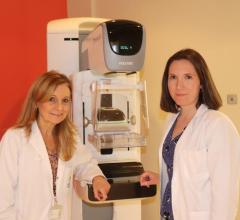September 25, 2008 – According to Naviscan Inc., positron emission mammography, or PEM, which uses advanced metabolic imaging to detect breast tumors in the crucial early stages, is giving doctors a new tool to help women beat breast cancer.
The Naviscan PEM Flex Solo II reportedly can produce high-resolution images of 2 mm resolution, allowing physicians to visualize the presence of tumors the size of a grain of rice.
The PEM Flex is similar to the size of a mammography unit and consists of two high-resolution detector heads mounted directly to breast immobilization paddles that are positioned to optimize imaging of the breast. The close proximity of crystal detectors and tomographic reconstruction produces the high-resolution images.
According to the company, an independent study showed that PEM technology is more sensitive than MRI in detecting the smallest cancers. PEM demonstrated 91 percent sensitivity in ductal carcinoma in situ (DCIS) compared with 83 percent with MRI and better sensitivity in cancers less than five millimeters in size. PEM also detected a 2 mm DCIS case to be shown negative on MRI.
Another study of 400 patients in a multi-center clinical trial comparing PEM with MRI will be completed this month, according to the company.
Kathy Schilling, M.D., medical director of the Center for Breast Cancer in Boca Raton, FL, said that in the study PEM can accurately detected the most difficult to see cancers. According to Dr. Schilling, “The ability to image and diagnose these early stage cancers provides the potential for cure and will significantly impact breast cancer management.”
For more information: www.naviscanpet.com


 May 03, 2024
May 03, 2024 








